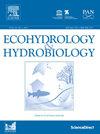中国北方富营养化浅湖表层沉积物细菌群落组合
IF 2.2
4区 环境科学与生态学
Q2 ECOLOGY
引用次数: 0
摘要
人为干扰对湿地生态系统产生负面影响,如富营养化水平增加。在多变的环境条件下,研究微生物空间分布的过程和机制对生物地球化学意义至关重要。为了了解白洋淀长期富营养化过程中沉积物细菌群落及其组合的变化,采用16S rRNA基因V3-V4区高通量测序方法对24个表层沉积物样品进行了微生物群落研究,并采用中性群落模型(NCM)对群落组合过程进行了表征。然后,利用基于零模型的β-最近类群指数(βNTI)对细菌群落的组装过程进行定量描述。通过βNTI量化的扩散限制占所有装配过程的64.6%。随着富营养化水平的提高,细菌群落组装的确定性过程可能会增强。此外,βNTI与水体NO3−或沉积物pH变化之间的显著相关性可能导致确定性过程。白洋淀沉积物内部存在一定的选择压力。中性群落模型很好地解释了细菌群落的组装。NO3−、NH4+、pH和EC是影响细菌群落组成的主要因素。上覆水体NO3−、地表水NO3−和沉积物pH是驱动细菌聚集的三个最关键的环境因子。结果表明,第4组富营养化程度较高,确定性过程相对较强,应作为富营养化治理的指标进行监测。本文章由计算机程序翻译,如有差异,请以英文原文为准。
Bacterial community assembly in surface sediments of a eutrophic shallow lake in northern China
Anthropogenic perturbations make negative effects on wetland ecosystems, such as increasing levels of eutrophication. Under variable environmental conditions, studying the processes and mechanisms underlying their spatial distribution is critical to biogeochemical significance of microorganisms. In order to understand the changes in sediment bacterial community and their assembly with long-term eutrophication of the Baiyangdian Lake of China, we explored the microbial communities for 24 surface sediment samples using high throughput sequencing of V3-V4 region of 16S rRNA gene, meanwhile we employed Neutral community model (NCM) to characterize the community assembly processes. Then, the β-nearest taxon index (βNTI) based on a null model was used to provide a quantitative description of the assembly processes of the bacterial community. Dispersal limitation, quantified by βNTI, accounted for ∼64.6% of all assembly processes. As the increasing levels of eutrophication, deterministic processes of bacterial community assembly may be enhanced. Moreover, the significant correlation between the βNTI and change in water NO3− or sediment pH might lead to deterministic processes. There was some selection pressure acting within the Baiyangdian lake sediments. The neutral community model properly explained bacterial community assembly. The NO3−, NH4+, pH and EC were main influencing factors on the composition of the bacterial community. The overlying water NO3−, surface water NO3− and sediment pH were the three most crucial environmental factors to drive bacterial assembly. The findings revealed that Group 4 with relatively stronger deterministic processes as a more eutrophic area should be monitored as an indicator for eutrophication governance.
求助全文
通过发布文献求助,成功后即可免费获取论文全文。
去求助
来源期刊

Ecohydrology & Hydrobiology
Agricultural and Biological Sciences-Aquatic Science
CiteScore
5.40
自引率
3.80%
发文量
51
期刊介绍:
Ecohydrology & Hydrobiology is an international journal that aims to advance ecohydrology as the study of the interplay between ecological and hydrological processes from molecular to river basin scales, and to promote its implementation as an integrative management tool to harmonize societal needs with biosphere potential.
 求助内容:
求助内容: 应助结果提醒方式:
应助结果提醒方式:


